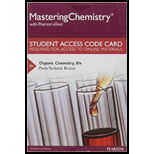
(a)
Interpretation:
Most stable
Concept introduction:
The amount of heat released in a hydrogenation reaction is known as heat of hydrogenation
The most stable alkene has the smallest heat of hydrogenation.
The stability of an alkene increases as the number of alkyl substituents bonded to its
The stability of an alkene increases as the number of hydrogen bonded to its
(b)
Interpretation:
Least stable alkene has to be identified.
Concept introduction:
The amount of heat released in a hydrogenation reaction is known as heat of hydrogenation
The most stable alkene has the smallest heat of hydrogenation.
The stability of an alkene increases as the number of alkyl substituents bonded to its
The stability of an alkene increases as the number of hydrogen bonded to its
Want to see the full answer?
Check out a sample textbook solution
Chapter 5 Solutions
Organic Chemistry Study Guide and Solutions Manual, Books a la Carte Edition (8th Edition)
- What is the name of the following compound? SiMe3arrow_forwardK Draw the starting structure that would lead to the major product shown under the provided conditions. Drawing 1. NaNH2 2. PhCH2Br 4 57°F Sunny Q Searcharrow_forward7 Draw the starting alkyl bromide that would produce this alkyne under these conditions. F Drawing 1. NaNH2, A 2. H3O+ £ 4 Temps to rise Tomorrow Q Search H2arrow_forward
